#mudbugs
Explore tagged Tumblr posts
Text
Hey quick question:
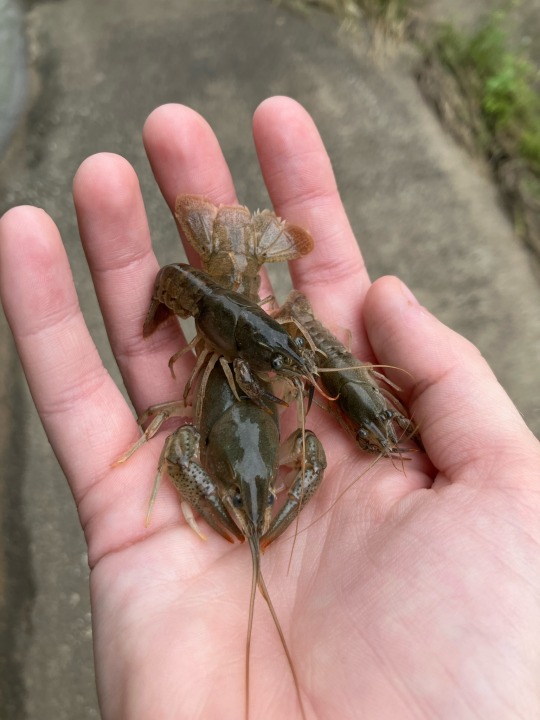
#Owl Hoots#poll#polls#tumblr poll#tumblr polls#crawfish#crayfish#mudbugs#mudbug#crawdads#crawdad#ID in Alt
65 notes
·
View notes
Text
-thinks about crayfish-
-skin clears, my muscles become strong and flexible, my nervous system heals, I am imbued with energy and life, my mind is free of all anxiety and pain, I have the irresistible urge to pinch people-
🦞🦞🦞🦞🦞🦞🦞
0 notes
Text
Wet Beast Wednesday: crayfish
It's week 3 of fresh-uary, the month where I only cover freshwater species for Wet Beast Wednesday. This week's topic is the crayfish, also known as the crawfish, crawdad, mudbug, lobster, yabby, kōura, and a lot of other names. The various names for crayfish are also applied to a variety of saltwater species that aren't the topic of today's post, so there's some confusion over terminology when discussing these creatures. Let me clear some of that up and explain why it's ok to be cray.
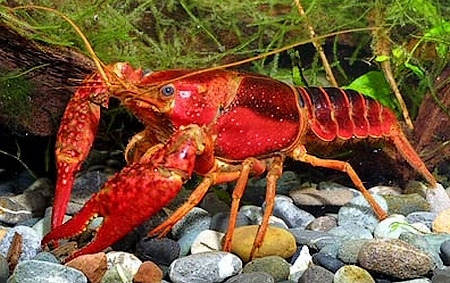
(Image: a red swamp crayfish (Procambarus clarkii), seen from the side. It is a long, lobster-like crustacean with a rigid front half and flexible tail ending in a wide fan. It walks on 8 legs and has a large pair of pincers held in front of the body. The head ends in a pointy snout with two eyes on short stalks and two pairs of antennae. This one is mostly red, with darker portions on the back. End ID)
The crayfish I'm covering today are freshwater members of the clade Astacidea. This clade also contains clawed lobsters, so there is a lot of similarity between the two groups. There are four families of crayfish, split between two superfamilies. These families are largely split up by region. The superfamily Astacoidea are known as northern hemisphere crayfish and contains the families Cambaroididae (found in eastern Asia), Astacidae (found in west Asia, Europe, and Western North America), and Cambaridae (found in eastern North America). The superfamily Parastacoidea, or southern hemisphere crayfish, contains the family Parastacidae, members of which live (or used to live) in South America, Madagascar, and Australia and New Zealand.
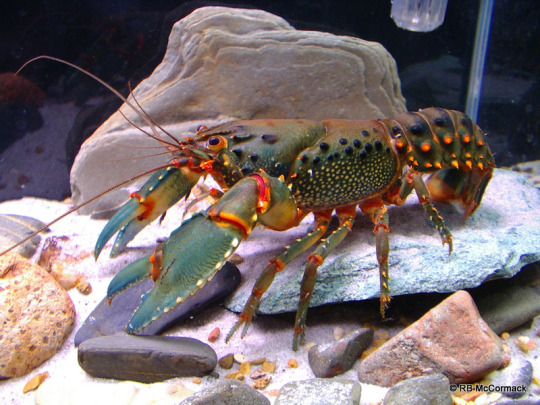
(Image: The Sydney spiny crayfish (Euastacus spinifer) seen from the side. It is a dark green in color, with orange outlines and orange and black spines around the body. End ID)
Crayfish are very similar to clawed lobsters in appearance and have a fairly typical decapod body plan. Their bodies consist of 20 segments grouped into two main body parts: the cephalothorax and abdomen. The cephalothorax is rigid, covered by the carapace, and contains the head and attachments for the legs. The head includes two stalked eyes, two sets of antennae, and a sideways opening mouth surrounded by leg-like maxillipeds that help manipulate food. As a decapod, crayfish have 10 legs. Like their clawed lobster cousins, crayfish use four pairs for walking while the front pair have been modified into a pair of large pincers used for defense and capturing food. Lost limbs can be regrown, though it takes a while. The abdomen forms the flexible "tail". Each segment of the abdomen contains a pair of appendages called pleopods or swimmeretes. These help circulate water and can be used to swim in juveniles. In males, the first pair of pleopods is modified into grasping structures used to hold onto the female during mating. The abdomen ends with a fan-like structure called the telson, that acts like a fin. By rapidly curling its abdomen beneath it, a crayfish can shoot backwards away from danger. The largest species of crayfish, and largest freshwater invertebrate, is Astacopsis gouldi, the giant Tasmanian freshwater crayfish. It can reach 80 cm (31 in) long and 6 kg (13 lbs), though such large individuals are rare. Most crayfish species are considerably smaller.
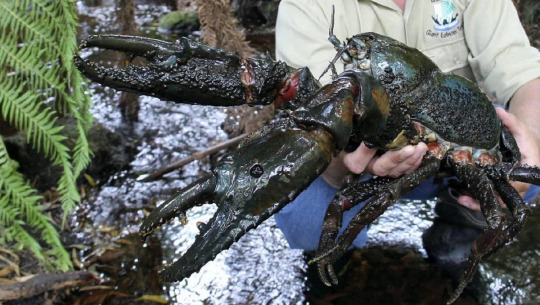
(Image: someone holding a giant Tasmanian crayfish up to the camera. It is extremely large for a crayfish, requiring two hands to hold and its pincers are roughly as long as the person's hands. It is a dark, swampy green to black in color, with many small lumps on the body. End ID)
Crayfish are benthic omnivores and detritovores found in both running and still water. Crayfish are opportunistic feeders with extremely varied diets that include plants, fungi, animals, microorganisms, and decaying organic matter. Mist species are considered primarily herbivorous and scavengers, though they will take live prey if the opportunity arises and have been known to be cannibalistic. Decomposing organic matter forms a large portion of the crayfish diet and they often eat it through the mud and slime found on the bottom of their habitats. A crayfish can quickly swallow mud, then internally sort it by the size of ingested particles. Coarser materials are processed and excreted faster. The digestive tract can process the dead plankton and decaying organic matter that makes up mud from the sediment. Feces are excreted wrapped in a peritrophic membrane. This membrane is rich in proteins and is usually eaten by the crayfish to regain them and get a second shot at digesting organic matter in the feces. Fresh vegetation is also a major food source and there are even reports of crayfish leaving the water to graze on land plants. Crayfish feed periodically, switching between periods of feeding and periods of hiding while they digest. As with all crustaceans, crayfish have to regularly molt their exoskeletons as they grow. They typically eat their old carapaces to regain the calcium carbonate and other molecules contained in the shell. After molting, it takes time for the new exoskeleton to harden, leaving the crayfish more vulnerable to injury or predation.

(Image: a small, orange crayfish in captivity inspecting a cucumber slice that is being offered as food. End ID)
Crayfish mate seasonally, usually in spring through late summer, triggered by changes in water temperature. The exact mating process depends on species, though females are likely to release pheromones to attract males. Males are initially aggressive, but often calm down sometime before mating. Males are known to fight over access to females. In some species, the male and female will touch claws and exchange chemical signatures prior to mating possibly as a courtship ritual. Males have also been seen attempting to mate with other males. Once a female accepts a mate, the male will flip her onto her back and align their abdomens, using his modified first pair of pleopods to grab on. Once their genitals are aligned, the male will pass a sac of sperm to the female using structures called gonopods. The male will leave after mating. The female lays clusters of eggs that are carefully attached to the pleopods. Until the eggs hatch, the mother will carry them with her, moving her pleopods to circulate water around them and using her legs to clean them. Egg development can takes days to weeks depending on species. The young are born well developed for crustaceans, looking like miniature adults. The female will shake her pleopods to help the hatchlings emerge. Juveniles are at a high risk of predation, including from other crayfish, so only a few of the possible hundreds of eggs will reach adulthood. It can take years for a crayfish to reach sexual maturity.
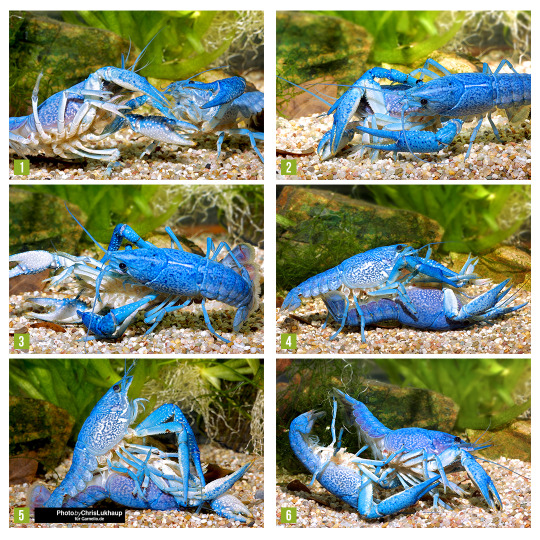
(Image: a series of 6 photos showing two blue crayfish mating. In the first three photos, the male turns the female on her back. In the 4th photo, the male starts to line up his abdomen with hers. In the 5th photo, the abdomens are aligned and mating is occurring. In the last photo, the male climbs off of the female. End ID. Source)

(Image: a female crayfish being held upside down to show her eggs, visible as small, black balls attached to the underside of the abdomen. End ID)
Crayfish are edible and eaten worldwide, with 95% of the world supply coming from China. Boiling is the most common form of cooking. Experiments have shown that crayfish take a while to die when boiled and show pain responses. They also release cortisol, a stress hormone, when boiled. There is, for some reason, a debate on whether or not crustaceans can feel pain. I think that it's obvious they have negative responses to negative stimuli and therefore it can be safely assumed that they can suffer. To more humanely cook a crayfish, freeze them for a few hours to render them unconscious, then cut down the body lengthwise to destroy the nervous system before boiling. Crayfish are also kept in aquariums as pets and can be fed shrimp pellets and plants, but they may also try to eat other organisms in the same tanks. In the wild, many species of crayfish are threatened by overfishing, habitat loss, climate change, and pollution. Most species need clean water and are highly vulnerable to pollutants. This allows crayfish to be used as an indicator species for the health of their environments. The pseudofungus Aphanomyces astaci causes a fatal disease called crayfish plague that has escaped from aquacultures to affect wild populations. Side note, I had no idea pseudofungi were a thing until right now. Multiple species of crayfish have become invasive species after accidental or intentional release of common food species. Other invasive species can outcompete or prey on native species.
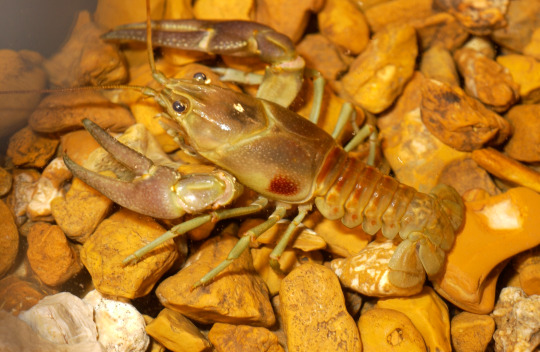
(Image: the rusty crayfish (Faxonius rusticus), a common invasive species in North America, identifiable by the rust-red blotch located on the sides of the carapace near the rear of the cephalothorax. End ID)
#wet beast wednesday#crayfish#crawfish#crawdad#yabby#yabbies#kōura#mudbug#graphic crayfish sex#crustacean#invertebrates#invertiblr#freshwater#claws#ecology#biology#zoology#animal facts#informative#educational#image described
92 notes
·
View notes
Text
Silly MudBug Dragon
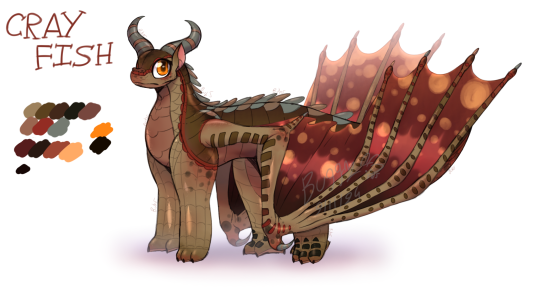
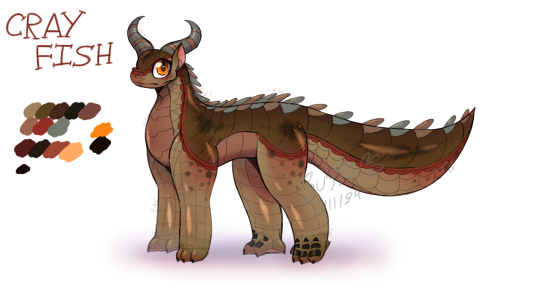
(Winged & Unwinged except drawing wof Dragons w/o wings makes me wanna throw myself off a frikin cliff. Also chonky tail.)
So heresa goober I decided to draw for a frend that's apart of theor WoF Universe called "Reign of Ruin* which is uh.... a more mature version of WoF.. (As in it does contain curse words but I kinda don't care as I am used to it even tho I'm not really the type to curse unless i need to.)
The wings were basically hell for me. I h8 drawing dragon wings, but considering I HAVE TO SUFFER TO MAKE ART- IdK MaN-
Anyways on my way to put this gremlin in a pot & eet it with lime PS sauce. /j
Credits
Character was designed by me.
Art is mine.
Program: IbisPaint
Bubs' TOS: Plz don't repost/steal, trace, or recolor my art WITHOUT MY PERMISSION! If you do, I'll take yur femur and pelvis.. SO, DON'T THINK ABOUT IT! (The PNS on my blog's pinned post clearly means "Please No Steal" plz follow that rule.) If you do post my art on anything like yur blog or somewhere else (With my permission) PLEASE CREDIT ME!
#neptuniadoesstuff#art#oc#WoF#Wings of Fire#WoF: Reign of Ruin#Crayfish (OC)#Mudwing#Tasty MudBug Dragon /j#Drawing dragons makes me suffer
23 notes
·
View notes
Text
Is sue eating ass out there wtfffff?????
9 notes
·
View notes
Text
How To Catch Crayfish | Crayfishing Tips
youtube
Check out these MONSTEROUS crayfish
#crayfish#crawfish#crawfishing#crayfishing#fishing#big crayfish#big crawfish#mudbug#mudbugging#Youtube
2 notes
·
View notes
Text
SEND 🍺 + A QUESTION & MY MUSE WILL ANSWER DRUNK. ──────────────────────────────
@lovepvnch sent: 🍺 + "will you please please please visit home with me when we get to the city? you can meet mudbug !!"
──────────────────────────────
VAGUELY, HE THINKS, Hmm . . . Sounds like a bad idea, somehow. This is the logical part of his brain, of course; it has been getting quieter & quieter with every drink. The emotional part of his brain, on the other hand, where all of his whimsy & desires can be found, has become MUCH LOUDER with every drink.
Puck gasps, ❝ Ohmygods, Mudbug . . . !❞ She's nodding her head with great enthusiasm now. ❝ Yes, yes, yes. I want to meet Mudbug. I want to see how that thing runs. Bet it looks funny. Like Iago. Hehehe. Did you know Iago runs funny ?❞

He looks at Tempest, eyes squinting in thought. ❝ How fluffy is that beast, by the way ?No, wait, don't tell me. It'll be a surprise. ❞
#lovepvnch#hes gonna start spiraling in two seconds like OH FUCK... WHAT IF I PUNT MUDBUG INTO THE SUN#hes gonna start crying really hard. Oof#&&. ALL GOOD CITIZENS OF WYRMLANDS!HARKEN UNTO THESE WORDS!☠ 𝐈𝐍𝐁𝐎𝐗。#&&. RABID DIRTY DOG!☠ 𝐈𝐂。
2 notes
·
View notes
Text

#I have nothing but respect for the Americans who just called them lobsters like fuck it#however. this is a crawdad
1K notes
·
View notes
Text



水路の水量が減ったら、水底にアメリカザリガニがちらほらいるのが見えた(7月15日)
0 notes
Text
🦇Ballentry Moor🦇



Joan Clayton x fem!reader
tags: Dark, Pining, Hurt No Comfort, very vaguely implied past assault, very subtext-heavy, Bathing/Washing, nonsexual nudity, Older Woman/Younger Woman, Unrequited Love?, Loneliness, lots of spit stuff for some reason?, SFW otherwise
summary: Once upon a time, Joan saved you and took you back to her cabin. You've been living with her ever since, and with time, you have developed feelings for her. The challenge is trying to make her understand that.
wc: ~ 2.5 k (Chapter 1/2)
*******************************************************
The fog never lifted from Ballentry Moor. A heavy blanket and smothering embrace at once, spreading gloom and offering refuge from witness' eyes. You had fallen victim to the moor, once upon a time, and lay in its murky soil, returned to and devoured by Mother Earth with vines slung around your wrists and ankles, until the swamp witch herself had cut you free.
You'd gone home with her, treading the same path you were following now in the muted indigo hues of twilight, back to her dilapidated brick house with a wicker basket full of mushrooms and roots on your arm. Stepping through the front door, the scent of vegetable broth boiling in the cauldron filled your nostrils. Joan stood next to it, with her back turned towards you, and stirred.
"Fortune smiled upon me today," you announced, heading straight to the kitchen table, where you set down your basket and began picking out mushrooms. "Harvest was good."
Joan acknowledged you with a hrmpf noise, as was her manner, and you returned your attention to the mushrooms, proceeding to wash them and taking out a chopping board and knife that could do with a sharpening. As you chopped them into slices and cubes, your gaze kept flitting to her, tossing basil into the cauldron, tasting from the iron ladle, pouring more salt into it as if it were not over-salted already.
"I feel it," she said, lifting her head and pausing her stirring.
"Hm?"
"You look at me with want."
The knife—suddenly forgotten about—escaped your control and cut into your finger instead of the mushroom. You hissed and dropped the knife with a loud clink, which prompted Joan to turn and size you up with a grim frown. Upon spotting the droplet of blood forming across the tip of your forefinger, she let the ladle fall into the cauldron and approached, grabbing your wrist to inspect the cut. You gasped when she took your finger into her mouth and sucked the blood off, then pushed your hand away, saying, "Paper cut. Cry, little babe."
You wiped your finger on your apron, cleaning her spit off it, in mild disbelief. The cut had already stopped bleeding. You finished chopping the mushrooms and took the cutting board to the cauldron, where Joan made space for you to scrape them into the broth. The steam wafted into your face and glazed it damp; your cheeks reddened too over the fire, but Joan's eyes on your movements had a similar effect.
"What is it you want, little mudbug?"
"Nothing of importance."
You avoided her eyes and left her proximity under the guise of putting the knife and cutting board away. Though the warmth behind your navel never ceased, neither did that in your cheeks. Joan hrmpf'ed again and tended to her broth.
-> continue on Ao3
#Joan Clayton x Reader#Joan Clayton#Joan clayton fanfic#penny dreadful#penny dreadful fanfic#patti lupone
86 notes
·
View notes
Note
the accessories you put on your plushies are so cute!!! if it’s not a hassle could you show some of your favourites?
Thank you!!


Very fond of the bandana I made for Snowdrop, imperfect but crafted with love
Same goes for Mudbug, also because he doesn't have his tag I put a earring in the hole it left!!



Some less personal accessories I like, Lunch is wearing some braclets I had as a kid, Sable is currently rocking the cowboy hat that I like to switch around, and Cardamom has a cute little collar with a bell


These two are my absolute favorites probably, I put a lot of love into them
No plush ID! Feel free to ask about any
37 notes
·
View notes
Text
Animal of the Day!
Sculptured Mitten Lobster (Parribacus antarcticus)
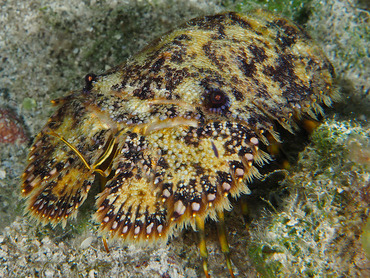
(Photo from Florent’s Guide)
Conservation Status- Least Concern
Habitat- Southern Pacific Ocean
Size (Weight/Length)- 20 cm
Diet- Mollusks; Shrimp; Crabs; Sea Urchins
Cool Facts- The sculptured mitten lobster is a friend-shaped crustacean. Their shovel-like body helps them to hide between rocks. In addition, their large body surface makes it very hard to pry them off a rock, forcing predators to face their tough shell. Over time, algae and barnacles grow on their shell and aides in their camouflage. Unlike the American lobster, sculptured mitten lobsters lack claws. The strange protrusions at the front of their head are actually modified antennae. The antennae are used to dig through sand in search of mollusks to munch on.
Rating- 11/10 (Lovingly called mudbugs.)
#animal of the day#animals#crustaceans#lobster#monday#august 28#sculptured mitten lobster#slipper lobster#biology#science#conservation#the more you know
292 notes
·
View notes
Text
I Put A Camera In My Yabby Net (Crawfish Trap For American Viewers)
youtube
4 notes
·
View notes
Text
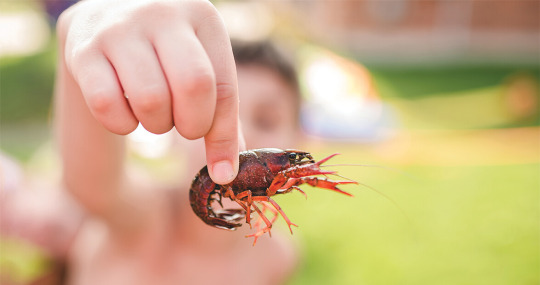
56 notes
·
View notes
Text
The hard truth.
bugs is shrimps.........
You Might Think of Shrimp as Bugs of the Sea. But a Remarkable Discovery Shows the Opposite: Bugs Are Actually Shrimp of the Land
A recent study suggests that insects branched out from crustaceans on the tree of life
Riley Black - Science CorrespondentApril 9, 2025
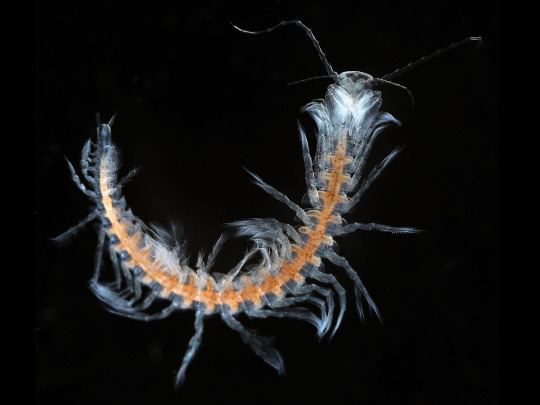
A species of remipede known from the Caicos Islands. The photograph was taken by a member of a multinational team looking for rare species. Remipedes are crustaceans that are close relatives to insects. Jørgen Olesen / Natural History Museum of Denmark, Brett Gonzalez, Karen Osborn, GGI
Shrimp look an awful lot like bugs. The exoskeletons, jointed legs and compound eyes of both groups of living things give them more than a passing resemblance to each other, so no wonder some people call shrimp-like crawfish “mudbugs,” and a tattoo reading “shrimps is bugs” became a viral meme for underscoring the resemblance. But the tattoo got the reality backwards. Shrimp are not bugs. Bugs—or, more properly, insects—are technically a form of crustacean.
Biologists of many different subdisciplines categorize life in a field called systematics. Living things of all sorts, both extant and extinct, are constantly being compared and evaluated to build what we so commonly think of as the tree of life. The addition of new species and novel analyses are constantly reshaping that evolutionary tree, and sometimes the category changes shift more than just a few twigs but entire evolutionary branches. Birds are now known to be dinosaurs, for example, whales are technically hoofed mammals called artiodactyls, and, thanks to a 2023 study in Molecular Biology and Evolution, insects have been shifted into the same group as shrimp and crabs called pancrustacea.
The realization that bugs were close relatives of crustaceans took almost a century of curiosity to uncover. Paleontologist Joanna Wolfe of Harvard University, one of the authors of the 2023 study, notes that researchers noticed some insects and crustaceans had the same structures in their eyes and nervous systems. The resemblance could have been the result of convergent evolution, when two groups independently evolve in the same way, and so the idea that insects are modified crustaceans didn’t catch. But the hypothesis didn’t fully go away, either.
In 2013, Wolfe and colleagues found that insects were the sister group, or next closest evolutionary relatives, to crustaceans called remipedes—which live in undersea caves and are the only venomous crustaceans. Remipedes were supposed to be oddballs that were shaped in strange ways due to their lives in caves. Now they were coming out as the closest relatives to the flies, mantises, bees and other insects we see around us on land. “At that time, I was shocked and thought there was something wrong with our results,” Wolfe recalls, only to have additional evidence make the connection between insects and crustaceans stronger. The 2023 analysis, based on genetic data, found insects next to remipedes in the middle of the various crustacean subgroups. Specifically, insects fit within a wide group of crustaceans called allotriocarida that not only includes remipedes, but also other unusual groups such as shrimp-like branchiopods and worm-like cephalocarids sometimes called “horseshoe shrimp.” To put it another way, insects are to crustaceans as bats are to mammals—a subset that belongs to a broader group despite seeming so different from their closest relatives.

When birds were recognized as dinosaurs, the change did more than reshuffle their place on the evolutionary tree. “The change showed us how characteristics that we typically associate with birds today, such as feathers, hollow bones and air sacs, were widely found within Dinosauria,” Jukar says. Paleontologists began finding more feathered dinosaurs and dinosaurs with traits previously associated with birds, such as complex systems of air sacs as part of their respiratory systems, once the connection was made. The newly understood relationship between birds and other dinosaurs has allowed experts to better understand why only birds survived the mass extinction of 66 million years ago. Comparisons between birds and bird-like dinosaurs revealed that adaptations for eating seeds and nuts that some birds developed during the Cretaceous allowed them to survive while bird-like raptors perished.
The recognition that whales are hoofed mammals occurred around the same time as birds were found to be dinosaurs. The shift had a deep effect on how paleontologists carried out their research as well as the identity of the blubbery mammals. Prior to the 1990s, the earliest whales were thought to have evolved from carnivorous mammals called mesonychids. The beasts, sometimes called “wolves with hooves” because they looked like canids with hoof-like toes, were some of Earth’s most prominent carnivores around 55 million years ago, the time when amphibious whales such as Pakicetus began swimming in the shallows. But genetic evidence kept grouping whales close to hippos and other mammals with hoofed toes, called artiodactyls. Experts debated the connection, but by 2001 paleontologists uncovered early whale ankle bones that possessed traits only seen among artiodactyls. The recognition shifted where whales fit in the mammalian evolutionary tree and recalibrated what sort of ancestral creatures paleontologists should be looking for, yielding the 2007 discovery that whales most likely evolved from small, deer-like creatures in ancient India. Without the recognition that whales are artiodactyls, the relevance of those ancient, hoofed creatures to the origin of whales would have been entirely missed and paleontologists would still be wondering where orcas and minke whales came from.
In the case of the bugs, Wolfe notes, the recognition that insects shared a close common ancestor with remipedes helps narrow down where and how insects originated. “For me, the exciting part for insects is the recognition that they do not come from a terrestrial ancestor,” Wolfe says. Until recently, the ancestors of insects were thought to be more millipede-like and evolved once invertebrates began to live on land. Now, Wolfe notes, the closest relatives of insects are wiggly crustaceans that live in marine caves. The connection doesn’t mean that remipedes embody the exact ancestral form of the first insects, but rather that their close relationship will cause experts to rethink where insects came from and how they evolved. The effort will require tracing the ancestry of remipedes and other crustaceans, as well as searching for insects in the fossil record—both from new fossil sites and perhaps miscategorized fossils already in collections. “There’s a complicated history and still missing pieces,” she notes, but now biologists have a better sense of what to search for. Bugs are crustaceans, and now experts can begin to wonder how that came to be.
5 notes
·
View notes
